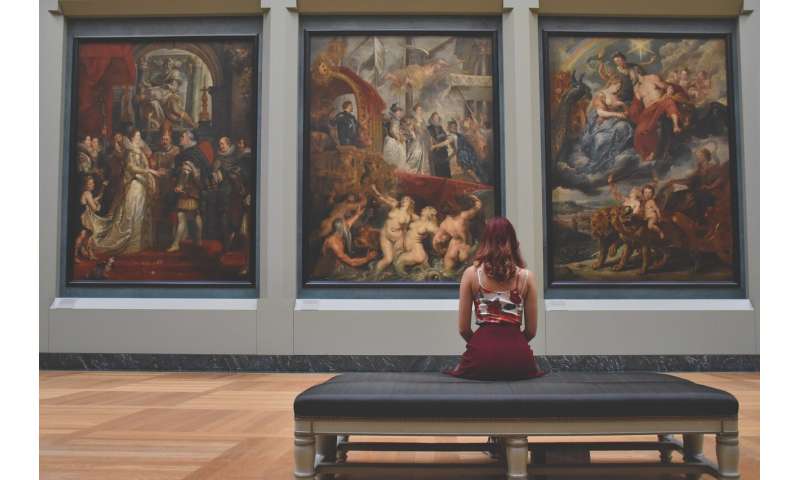by Bob Yirka , Tech Xplore

Credit: Pixabay/CC0 Public Domain
A team of researchers affiliated with a host of institutions in Korea and one in Estonia has found a way to use math to study paintings to learn more about the evolution of art history in the western world. In their paper published in Proceedings of the National Academy of Sciences, the group describes how they scanned thousands of paintings and then used mathematical algorithms to find commonalities between them over time.
Beauty, as the saying goes, is in the eye of the beholder—and so it is also with art. Two people looking at the same painting can walk away with vastly different impressions. But art also serves, the researchers contend, as a barometer for visualizing the emotional tone of a given society. This suggests that the study of art history can serve as a channel of sorts—illuminating societal trends over time. The researchers further note that to date, most studies of art history have been qualitatively based, which has led to interpretive results. To overcome such bias, the researchers with this new effort looked to mathematics to see if it might be useful in uncovering features of paintings that have been overlooked by human scholars.
The work involved digitally scanning 14,912 paintings—all of which (except for two) were painted by Western artists. The data for each of the paintings was then sent through a mathematical algorithm that drew partitions on the digital images based on contrasting colors. The researchers ran the algorithm on each painting multiple times, each time creating more partitions. As an example, the first run of the algorithm might have simply created two partitions on a painting—everything on land, and everything in the sky. The second might have split the land into buildings in one partition and farmland in another.
The researchers then ran other algorithms designed to look for patterns between the paintings. Doing so allowed them to see trends such as painting styles that predominated during certain eras. It also allowed them to see long-term trends, such as the placement of the horizon. The researchers found that over the past several hundred years, painters have been placing it increasingly higher. In the 17th century, the separation between Earth and sky dominated landscapes—those done in more modern times, in sharp contrast, have the horizon very near the top of the canvas.
Explore further
A team of researchers affiliated with a host of institutions in Korea and one in Estonia has found a way to use math to study paintings to learn more about the evolution of art history in the western world. In their paper published in Proceedings of the National Academy of Sciences, the group describes how they scanned thousands of paintings and then used mathematical algorithms to find commonalities between them over time.
Beauty, as the saying goes, is in the eye of the beholder—and so it is also with art. Two people looking at the same painting can walk away with vastly different impressions. But art also serves, the researchers contend, as a barometer for visualizing the emotional tone of a given society. This suggests that the study of art history can serve as a channel of sorts—illuminating societal trends over time. The researchers further note that to date, most studies of art history have been qualitatively based, which has led to interpretive results. To overcome such bias, the researchers with this new effort looked to mathematics to see if it might be useful in uncovering features of paintings that have been overlooked by human scholars.
The work involved digitally scanning 14,912 paintings—all of which (except for two) were painted by Western artists. The data for each of the paintings was then sent through a mathematical algorithm that drew partitions on the digital images based on contrasting colors. The researchers ran the algorithm on each painting multiple times, each time creating more partitions. As an example, the first run of the algorithm might have simply created two partitions on a painting—everything on land, and everything in the sky. The second might have split the land into buildings in one partition and farmland in another.
The researchers then ran other algorithms designed to look for patterns between the paintings. Doing so allowed them to see trends such as painting styles that predominated during certain eras. It also allowed them to see long-term trends, such as the placement of the horizon. The researchers found that over the past several hundred years, painters have been placing it increasingly higher. In the 17th century, the separation between Earth and sky dominated landscapes—those done in more modern times, in sharp contrast, have the horizon very near the top of the canvas.
Explore further
Composing creativity: Children benefit from new painting materials
More information: Byunghwee Lee et al. Dissecting landscape art history with information theory, Proceedings of the National Academy of Sciences (2020).
More information: Byunghwee Lee et al. Dissecting landscape art history with information theory, Proceedings of the National Academy of Sciences (2020).
DOI: 10.1073/pnas.2011927117
Journal information: Proceedings of the National Academy of Sciences
© 2020 Science X Network
Journal information: Proceedings of the National Academy of Sciences
© 2020 Science X Network
No comments:
Post a Comment